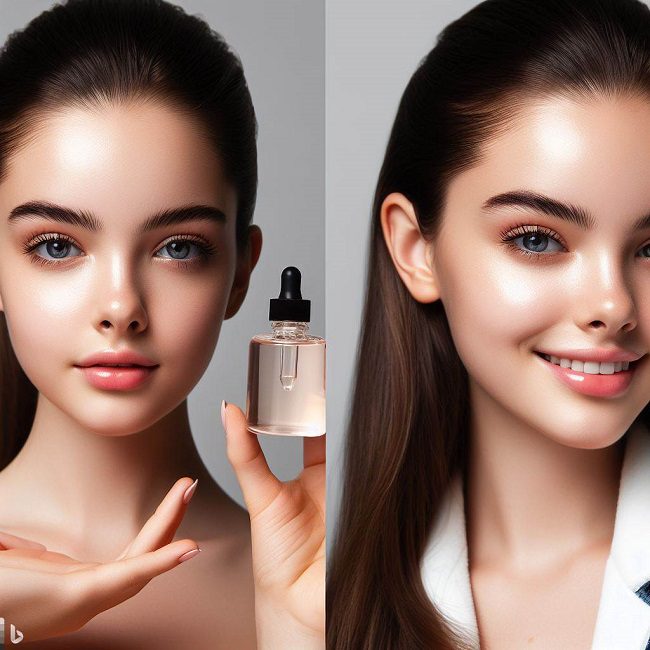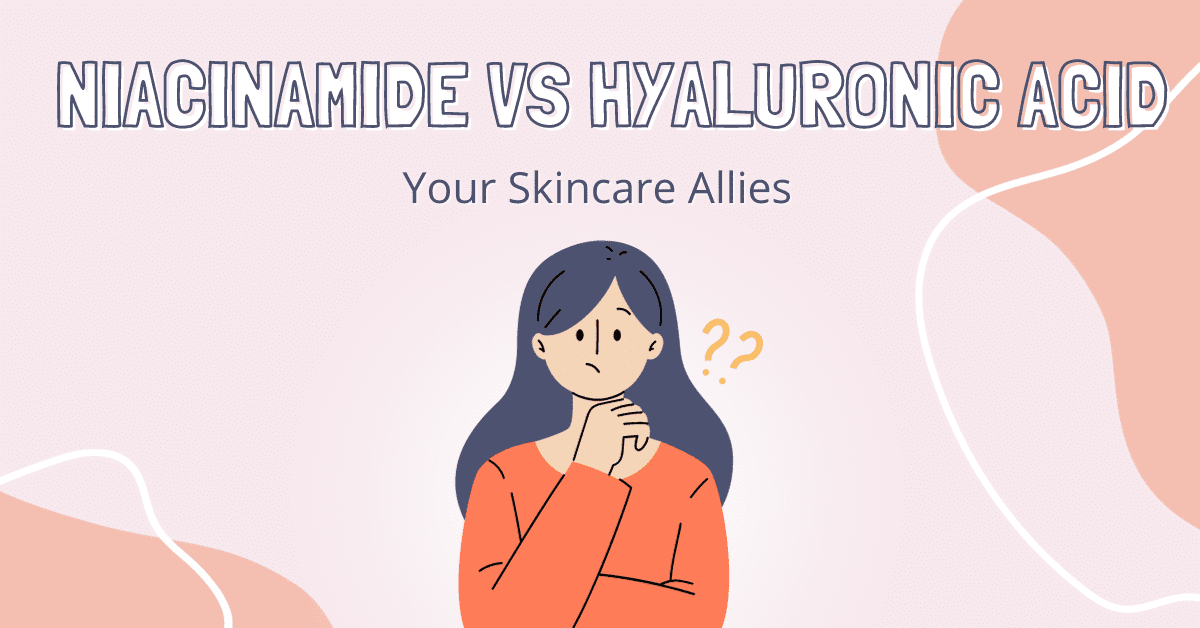There are a tonne of options when it comes to skincare products, but two components stand out as popular choices: hyaluronic acid vs niacinamide. They individually address distinct skin requirements and provide special advantages.
Hyaluronic acid is the ultimate hydration hero, while niacinamide is praised for its adaptability in treating issues including redness, fine wrinkles, and uneven tone. However, how can you determine which to utilize when?
We’ll examine the benefits, distinctions, and best practices for adding niacinamide vs hyaluronic acid to your skin care regimen in this research, empowering you to make wise decisions for a radiant complexion.
In This Article
What are Niacinamide and Hyaluronic Acid?

Niacinamide
One water-soluble version of vitamin B3 that has garnered popularity as a skincare superpower is niacinamide. It provides a wide range of advantages for the skin. Widely acceptable for a variety of skin types, niacinamide is praised for its adaptability.
Hyaluronic Acid
In contrast, hyaluronic acid is a sugar molecule that is found naturally in the skin and connective tissues. It is a powerful hydrator since its primary purpose is to hold onto water. Hyaluronic acid is excellent when applied topically because it keeps the skin moisturized, giving the appearance of smooth and plump skin.
What are the Advantages of Hyaluronic Acid and Niacinamide?
Niacinamide Benefits
- Reduces Inflammation: Niacinamide calms redness and inflammation by soothing sensitive skin.
- Minimises Pores: Smoother skin might result from a noticeable reduction in the appearance of enlarged pores.
- Evens Skin Tone: Niacinamide is well known for its capacity to reduce uneven skin tone and eliminate dark spots.
- Addresses Fine Lines: It makes wrinkles and fine lines less noticeable, giving the complexion a more youthful appearance.
- Adaptable to All Skin Types: This widely adored substance works well on a variety of skin types, including sensitive skin.
- Protects the Skin Barrier: By strengthening the skin’s natural barrier, niacinamide enhances the skin’s capacity to hold onto moisture and protect itself from outside stresses.
Hyaluronic Acid Benefits
- Intense Hydration: The main function of hyaluronic acid is to retain water, giving the skin intense hydration.
- Plumps and Smoothes: It plumps the skin, making wrinkles and fine lines less noticeable and leaving the complexion smoother.
- Versatile for All Skin Types: This moisturizing component works well on dry, oily, and sensitive skin types.
- Restores Elasticity: Hyaluronic acid keeps the skin firm and supple, which gives the appearance of younger skin.
- Improves Absorption: It maximizes the efficacy of other skincare products by enhancing their absorption when applied topically.
What are the Differences Between Niacinamide vs Hyaluronic Acid?
| Aspect | Niacinamide | Hyaluronic Acid |
|
Type |
Water-soluble vitamin (B3) | The naturally occurring sugar molecule |
| Primary Function | Improves skin texture, addresses various skin concerns | Deep hydration, moisture retention |
| Benefits | – Reduces inflammation – Minimizes pores – Evens skin tone – Addresses fine lines | – Provides intense hydration – Plumps the skin – Reduces fine lines |
| Suitable for Skin Types | Suitable for all skin types, including sensitive skin | Suits all skin types, dehydrated skin |
| Specific Skin Concerns | Versatile; addresses various issues including redness, fine lines, and uneven skin tone | Mainly focuses on hydration and moisture retention |
| Key Advantage | Versatility and multi-purpose, soothing and protective properties | Exceptional hydration and moisture retention, plumping effect |
| Application in Routine | Can be used in both morning and evening routines | Typically used in both morning and evening routines |
| Interaction with Other Ingredients | Generally compatible with most skincare ingredients | Generally compatible with most skincare ingredients, but best used before heavier creams |
You May Also Like- Can You Use Lactic Acid and Retinol Together? Glow and Glam Corner
What do Hyaluronic Acid and Niacinamide have in Common?

In skincare, hyaluronic acid and niacinamide have several things in common even though they serve different purposes:
1. Topical Application
Skincare products including serums, moisturizers, and creams include both hyaluronic acid and niacinamide topically.
2. Compatibility
They are often well absorbed by a broad spectrum of skin types, which makes them adaptable options for different people.
3. Anti-Aging Effects
Although these chemicals serve different purposes, they both aid in the fight against aging. Niacinamide treats problems including wrinkles and uneven skin tone, while hyaluronic acid plumps the face and minimizes the appearance of fine lines.
4. Benefits of Hydration
Although hyaluronic Acid is well known for its ability to hydrate, Niacinamide can also promote skin hydration indirectly by preserving the integrity of the skin barrier.
5. Protection
The skin is better off with both of them. Hyaluronic acid helps to retain the hydration and resilience of the skin, while niacinamide can assist in protecting the skin barrier.
6. Versatility
Both components may be used in a variety of skincare regimens and can be used to address a range of skin issues.
Hyaluronic Acid vs Niacinamide: Drawbacks

Although niacinamide and hyaluronic acid are typically well-tolerated and have many advantages, there are a few possible drawbacks to take into account:
Hyaluronic Acid
1. Extremely Dry Environments: If hyaluronic acid isn’t sufficiently sealed with a moisturizer in extremely dry settings, it may suck moisture from the skin’s deeper layers, which might worsen skin dryness.
2. Concentration Matters: Some people may not like a tacky or sticky feeling on their skin caused by high hyaluronic acid concentrations in some products.
3. Sensitivity: While rare, hyaluronic acid sensitivity or allergic responses can occur in certain individuals. Patch testing new products is advised, particularly if you have sensitive skin.
Niacinamide
1. Minor Irritation: Niacinamide may in rare instances result in moderate skin irritation, such as redness or a burning feeling. Higher concentrations or those with extremely sensitive skin are more prone to experience this.
2. Incompatibility with Certain Products: When used with very acidic products, such as vitamin C, niacinamide may be less effective. Even if there could not be a drawback, to optimize its advantages, it’s critical to comprehend the possible interactions.
3. Slow Results: It could take some time for Niacinamide to start showing any real benefits. It usually takes constant use over many weeks to months to see noticeable results, therefore patience is needed.
You May Also Like- Korean Skincare Routine Day and Night – A Complete Guide
How to Use Both Ingredients: Hyaluronic Acid vs Niacinamide

Hyaluronic Acid
1. Cleanse: To get your skin ready, start with a mild cleanser.
2. Tone (Optional): If your regimen calls for it, use a toner to bring your skin’s pH balance in line.
3. Hyaluronic Acid Serum: Dab moist skin with a hyaluronic acid serum. This facilitates the acid’s efficient absorption of moisture.
4. Seal with Moisturiser: Use a moisturizer to seal in the moisture that the serum has left on your skin.
5. Sunscreen (AM Routine): To protect your skin, apply sunscreen to your entire face in the morning.
Niacinamide
1. Cleansing: Begin with a mild cleansing, just like you would with hyaluronic acid.
2. Tone (Optional): If preferred, use a toner.
3. Niacinamide Serum: Massage your face with the niacinamide serum. It may be incorporated into your nighttime and morning rituals.
4. Wait: Give the niacinamide serum a few minutes to seep into the skin.
5. Moisturise: Use a moisturizer to seal the serum’s advantages.
6. Sunscreen (AM Routine): Use sunscreen in the morning if you use niacinamide to prevent UV damage to your skin.
Don’t forget to gently incorporate these items into your regimen and see how your skin reacts. For healthier, more vibrant skin, the biggest results will come from using them consistently over time.
Questions Related to Hyaluronic Acid vs Niacinamide
Q1. Can I use niacinamide with hyaluronic acid?
Yes, you may combine niacinamide and hyaluronic acid in your skincare regimen. These are two elements that work nicely together. Niacinamide treats several skin issues, including redness, fine wrinkles, and uneven skin tone, while hyaluronic acid hydrates. First, apply hyaluronic acid to moist skin, and then niacinamide for optimal hydration.
Q2. For oily skin, which is better: hyaluronic acid or niacinamide?
For oily skin, niacinamide is frequently preferable. It can lessen the visibility of pores, lessen irritation, and control the production of oil. Hyaluronic acid is hydrating and works well for all skin types; however, niacinamide is especially beneficial for oily skin types.
Q3. Should I take niacinamide with hyaluronic acid or after it?
Hyaluronic acid needs to be used before niacinamide. Hyaluronic acid is applied to wet skin to help it absorb moisture. After it’s absorbed, use niacinamide to take care of your particular skincare issues.
Q4. What can you not mix with niacinamide?
The majority of skincare products may be used with niacinamide. When used with very acidic products, like vitamin C, it can be less effective. To prevent any possible interactions, it is best to apply them at distinct times.
Q5. What can hyaluronic acid be mixed with?
Being adaptable, hyaluronic acid may be combined with other components for skincare products. It blends nicely with the majority of products, including serums, moisturizers, and other moisturizing components. It increases the efficacy of your skincare regimen as a whole.
Q6. Is hyaluronic acid better than niacinamide?
Niacinamide and hyaluronic acid have different main functions. Niacinamide treats issues including redness, fine wrinkles, and uneven skin tone, while hyaluronic acid is great for hydration and a plumper complexion. Your skincare objectives will determine which one you should use, and they can complement one another.
Q7. Should I apply a moisturizer after using niacinamide?
Yes, using a moisturizer after niacinamide application is recommended. This keeps your skin moisturized and helps to seal the advantages of the serum. By forming a barrier of defense, a moisturizer keeps your skin pleasant and hydrated.
Hyaluronic Acid vs Niacinamide: In My View
My stance on the niacinamide vs. hyaluronic acid controversy is rather obvious. These giants of skincare are your partners rather than competitors in the pursuit of healthy, glowing skin. While hyaluronic acid offers the vital base of deep hydration, niacinamide is superior at treating skin issues including redness, uneven tone, and fine wrinkles.
When combined, they make a powerful team that provides a full range of skin health solutions. Therefore, the true query isn’t “Which is better,” but rather, “How can I use both to improve my skincare regimen?” The solution is to combine both for a comprehensive approach to gorgeous skin.
Hi, I'm Naznin! I really love making skin happy. I learned cool stuff about skincare and want to share it with you! Together, let's explore how to take care of our skin and feel awesome. Join me on this fun journey where we can be our beautiful selves!

